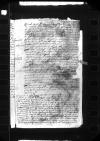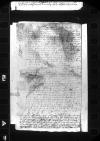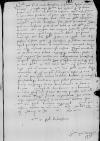List #3866
Ioannes DANTISCUS do [Samuel MACIEJOWSKI]Heilsberg (Lidzbark Warmiński), 1539-03-04
Regest polski:
Dantyszek jest zakłopotany wylewnością podziękowań, które [Samuel] Maciejowski złożył mu za skromny podarunek noworoczny, czuje się bowiem stale jego dłużnikiem. Gorąco dziękuje za zabiegi i wstawiennictwo u króla [Zygmunta I] i królowej [Bony Sforzy]. O dalszym ciągu jego problemów Maciejowski dowie się z listu biskupa chełmińskiego [Tiedemanna Giesego]. Dantyszek wychwala przymioty Giesego i prosi o poparcie spraw, w których zwraca się on listownie do króla w imieniu stanów pruskich.
Królowa zleciła Fabianowi Wojanowskiemu (Damerauowi), by przypomniał Dantyszkowi o obowiązku wierności królowi i wyliczył wyświadczone mu dobrodziejstwa, tak jakby ten o nich zapomniał. Dantyszek przesyła odpowiedź, jednak decyzję o jej doręczeniu królowej lub zniszczeniu pozostawia osądowi adresata. Napisał także do króla z podziękowaniem za szczodrobliwość okazaną jego poddanym. W związku z tą samą sprawą składa także podziękowania adresatowi i podkanclerzemu [Pawłowi Duninowi-Wolskiemu]. W liście do króla poruszył również pewne sprawy morskie. Przekazanie listu królowi uzależnia od decyzji Maciejowskiego.
Nie wiedząc, jakim trybem jego listy docierają do króla, Dantyszek prosi, by Maciejowski przekazał bezpośrednio królowi poufną wiadomość, że miasto Gdańsk wraz z księciem [pruskim Albrechtem Hohenzollernem] i miastem Elblągiem, wbrew królewskim zarządzeniom i ze szkodą zarówno Królestwa, jak i Prus, nie przestają bić monety; konsekwencją tego jest wzrost wartości złota i rzadkość pojawiania się w Prusach złotego pieniądza.
Dantyszek prosi o przesłanie za pośrednictwem posłańca Giesego [Michela Wicherskiego] informacji na temat odpowiedzi we wszystkich sprawach, w tym także od królowej.
W sprawie [Stanisława] Hozjusza Dantyszek ma u siebie cesję wszystkich praw przeciwnika [Aleksandra Suchtena]. Zwłoka w załatwieniu sprawy wynika z niedostarczenia przez Hozjusza pełnomocnictwa.
Rękopiśmienne podstawy źródłowe:
Publikacje:
| ||||||||
Tekst + aparat krytyczny + komentarzZwykły tekstTekst + komentarzTekst + aparat krytyczny
Reverende Domine, frater et amice carissime ac honoran(de) or honoran(dissime)⌈honoran(de)honoran(de) or honoran(dissime)⌉.
Salutem et omnem felicitatem.
cf.
Quod vero in cf.
Quomodo negotium hoc contra me indignationis successerit et quid quibusve modis hinc scripserim, non ambigo, quin Dominatio Vestra Reverenda ex litteris ad se
Quam felicissime valere ex animo aveo.
Dat(ae) or Dat(um)⌈Dat(ae)Dat(ae) or Dat(um)⌉
Dominationis Vestrae Reverendae deditissimus
Postscript:
Commiserat s(erenissima) or s(acra)⌈s(erenissima)s(erenissima) or s(acra)⌉
cf.
Unum tamen, quod maxime scribi oportuit, data opera omisi, de meis utpote  AAWO, AB, D. 7, f. 106v
Haec igitur Dominationi Vestrae Reverendae scribo in aurem, cum scripta mea ad maiestatem regiam superinscribed⌈ad
AAWO, AB, D. 7, f. 106v
Haec igitur Dominationi Vestrae Reverendae scribo in aurem, cum scripta mea ad maiestatem regiam superinscribed⌈ad
Ad superinscribed⌈AdAd superinscribed⌉ d(ominum) doctorem written over i⌈iemem written over i⌉
Iterum atque iterum Dominatio Vestra Reverenda valeat et me, q(uanto) va stain⌈[va]va stain⌉let, amet.


